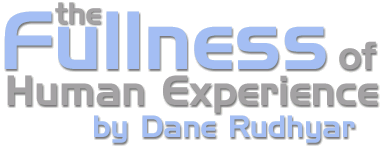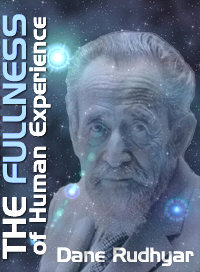 |
| Home | Bio | Art | Music | Literature | Civilization & Culture | Philosophy of Wholeness | Theosophy & Spirituality | Astrology |

CHAPTER EIGHT
Crises of Transition - 4 This biological situation underlay all types of socio-cultural and religious organization until the conquest of the American continent by an eminently aggressive and male-dominated race of human beings. This brutal conquest of enormous land-resources, which the native inhabitants had left nearly untouched, occurred simultaneously with the development of the scientific mentality in Europe, and with the many-pronged attempt to overcome the binding acceptance of the "divine right" of kings and bishops. These events provided the eventual set-up for the uncheckable expansion of the Industrial Revolution. The tremendous growth of industry in turn "dis-biologized" the reality, if not at first the concept and still-official ideal of the family. Women not only had to leave their homes consecrated to the propagation of life, often in order to insure the whole family-livelihood; simultaneously they had to introduce into their natural biological function certain intellect-developing male elements which could only alter their nature radically. Because these elements potentially transcend the biological level, by seeking to achieve absolute sociocultural equality between males and females, the Women's Liberation Movement disbiologized womanhood. It also disbiologized sex; it makes a personal issue of the full orgasmic experience of sexual activity. It had never been such a decisive issue in the traditional Christian European way of life. A "good woman" married a man (most often chosen by the parents for sociocultural and financial reasons) not to enjoy sexual relations with him, and not to "grow" as an individual person outside the experiences which the relationship with the husband and her children brought, but fundamentally in order to fulfill her biological and socio-religious function as sustainer and multiplier of a racial type and of the culture based on that type's biological characteristics. Thus the frequent proscription of marriage outside one's own race and religion or culture. The abortion issue can be approached objectively and unemotionally only if one sees how it developed out of the human situation outlined above. Another most important factor nevertheless has to be considered: the ability of the recent kind of medical science, based on the male analytical researcher's mentality, radically to alter the average length of the biological existence of a human body — a body, not a person. If more bodies are kept alive or made to survive what would have been a disastrous encounter with a predator (now, mainly bacteria and viruses), the strictly biological function of womanhood becomes less crucial. Homo sapiens may increase and multiply without many pregnancies! And because at the same time (an important point!) the socio-financial need for a woman to obtain a job — as a person and not as a biological organism — led to the development of the sociocultural and technological mind in persons born female, the disbiologizing and personalizing of sex was to be expected. It has led not only to the crucial attention given to techniques of sexual fulfillment, but to the spread of homosexuality. Sexual fulfillment is a "personal" experience; pregnancy is a biological process. The former inevitably had to be separated from the latter and given the most important role. Sexual permissiveness and the divorcing of sexual results from the biological type of family are direct results of the Industrial and Electronic Revolutions, and of the uncontrolled development and glorification of the scientific mentality. The latter, at the medical level, also made abortion biologically safe and easy, while the egocentric individualism of modern popular psychology and of the Human Potential Movement made it acceptable to at least the surface consciousness of the personal psyche. Today it is said that at least one-fourth of pregnancies in the United States each year (nearly two million) end in abortion. What is more, international organizations for world-population control accept the medical process as a legitimate procedure to achieve an end which has become a crucial human need — the need to stop the uncontrolled proliferation of millions of human bodies kept alive by medical means. These medical procedures contradict the rule of life in the biosphere; for in the biosphere, any sudden rise in the number of bodies belonging to a particular species is soon stopped by the increase of predators feeding on or destroying them. Is generalized abortion (and other anti-biological worldwide activities featured by Western civilization as a whole) the predator necessary to reestablish the balance of the biosphere; or is the state of this biosphere to be radically altered and thoroughly "humanized"? Will wilderness everywhere be transformed into gardens to satisfy the socialized and personalized desires of human beings? The free and generalized practice of abortion may be called a moral issue, but it is far more than ethical in a cultural-religious sense. It is a planetary issue. The validity of our Western civilization now spreading over the entire globe is an issue affecting the Earth-being as a whole. The devastation of the biosphere (and even of the sublunar regions) by a nuclear war is only one of many possibilities. Overpopulation in its extreme state, expected within the next 100 years, could be (with all its secondary results) just as disastrous. But to speak of it is not considered polite or acceptable to the religious mind, not only at the Fundamentalist or Catholic level of Christianity, but also in India, or Islamic countries, because "the will of God" is involved. But this God of theistic religions is the God of Life — who in the Bible is known as the Tetragrammaton, the fourfold IHVH who fashioned the human prototype Adam out of the red clay of the earth-surface. With Abraham he became the god of a special biological line — from seed to seed — and with Moses (or after his partial failure, Moses' successors) the god of a rigid culture and way of life. Even Jesus, who seems to have brought to Western humanity the vision of the "God within" —- the God of the free and autonomous individual person — spoke of Him as "my Father." One may assume that the use of the term "Father" was intended only in a symbolic sense; but the mind of the people to whom Christianity spread undoubtedly was operating mainly in terms of biological values, and the Catholic Church could not afford to ignore this fact. It also needed to maintain and increase its power through large families whose members it would physically control from birth. From the Christian Church's point of view, every human organism has at the center of his or her being — usually symbolized by the heart — a God-created Soul. As a biological organism a man is not a Soul: he has a Soul. This Soul was believed actually to "incarnate" (i.e. come into "the flesh," carne) in the child's body only around age seven, the age of reason and moral responsibility; only then could a child "sin." He or she does not sin as a body, but only after becoming a person. Today however, especially in America, children not only develop but are made to develop prematurely under the influence of the cultural environment (above all television) and expectations of the parents who have recently been taught by psychologists that the child must be considered "an individual" at birth and allowed to develop as such. Yet for a long time the potentiality of individualized selfhood can only actualize itself as an ego conditioned by the attempts of the infant's biological organism to adjust to the demands and expectations of its family and social environment. Does the operation of this ego already imply a full state of personhood and legitimate the application of the rights which our culture gives to all persons? Much evidently depends upon how one defines the ego, and whether one identifies this ego with the individual self, considered as the central factor in the state of personhood. Personhood is an evolving condition of being. It may be an overshadowing potentiality with definable characteristics before it is actualized at the concrete level of everyday existence within a socio-cultural setup. And if so, there may be a time when what is still only a potentiality may have to be considered a partially determining factor in the future actuality. It may be that the religious doctrines of the "incarnating" Soul refer to this overshadowing potentiality. In a sense this Soul is the ideal person; from a different perspective it is the dharma of the future infant as yet unborn. The over-shadowing of the fetus developing in the mother's womb by this ideal form could indeed refer to the phase of the gestation process which is, and especially was, called the moment of "quickening." Today the quickening usually refers to the first feeling a pregnant woman has of movements of the fetus within her womb. However, occult traditions gave a deeper significance to the event: it marked the beginning of a contact between what the future person was meant to achieve and the developing organism within the womb. In the past, this contact was believed to occur when the heart of the fetus began to beat — the heart being considered at least a symbol of centrality of being. Today, however, modern embryologists claim that their instruments can detect halting and imprecise vibrations of the foetal heart-muscles after about one month following impregnation, although a precise, individually sustained heart-beat rhythm is likely to be a different phenomenon. It was said to occur around the midpoint of pregnancy, thus at four-and-one-half months. If we accept such an interpretation, the midpoint of the gestation period could therefore be the decisive period when abortion would destroy not only the possibility of biological existence as a body, but that of functioning as a person within a human community in terms dictated by a collective culture. A biological organism can be "killed"; personhood may be destroyed. The two processes should be clearly differentiated. Personhood can be destroyed even if the body of the person is kept alive. Today senility means that personhood is no longer operative. If this occurs, the body kept alive no longer has any human "rights" because it is no longer truly "human." By permission of Leyla Rudhyar Hill Copyright © 1986 by Leyla Rudhyar Hill All Rights Reserved.  Web design and all data, text and graphics appearing on this site are protected by US and International Copyright and are not to be reproduced, distributed, circulated, offered for sale, or given away, in any form, by any means, electronic or conventional. See Notices for full copyright statement and conditions of use. Web design copyright © 2000-2004 by Michael R. Meyer. All Rights Reserved. |
 |
